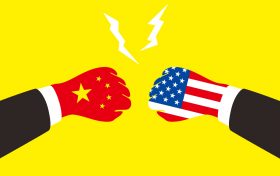Inside the Tech Tariff Catastrophe

High tariffs and export restrictions imposed by the Trump administration are snarling technology supply chains, threatening production, and forcing a dramatic shift in plans for a range of U.S. companies. And the outcome could be the opposite of what the government intends.
Tariff fears were among several factors contributing to today's steep selloff in the stock market, in addition to President Trump's comments criticizing and threatening to remove Federal Reserve Chair Jerome Powell. In mid-day trading, the Nasdaq Composite index was down 3%.
The longer that proposed tariff policies go without negotiated settlements, the bigger trouble for technology and other business. Without clear insight into the longer-term path of trade deals, executives will have trouble sourcing components, planning budgets, and figuring out where to build manufacturing facilities.
At the heart of the tech upheaval is the administration’s all-out trade war with China. In addition to the cumulative 145% tariff on imports from China, there are export restrictions on AI chips as well. As a result, tech vendors are predicting financial setbacks and uncertainty. Let’s look at a few tech firms at risk.
Apple and Qualcomm on High Alert
Top of the high-risk chart is Apple, which by most accounts relies on manufacturing in China for 80% of its products. The company also realized about 15% of its sales in “greater China” as of its most recent earnings statement for the quarter ended December 28, 2024.
To access the rest of this article, you need a Futuriom CLOUD TRACKER PRO subscription — see below.
Access CLOUD TRACKER PRO
|
CLOUD TRACKER PRO Subscribers — Sign In |















